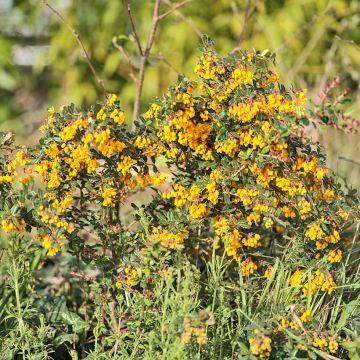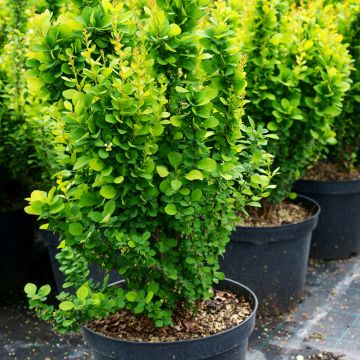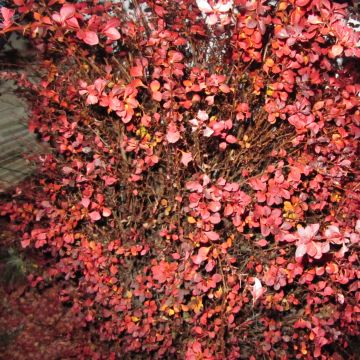

Berberis hybrido-gagnepainii Chenaultii - Barberry
Berberis hybrido-gagnepainii Chenaultii - Barberry
Berberis verruculosa x gagnepainii Chenaultii
Barberry
Large leaf fall, satisfactory packaging, young plant and mulched, we will be vigilant about its rooting. Beautiful plant with very well-rooted, surprising foliage, we will see how it goes through the winter, mulched.
Jaime, 29/11/2022
Special offer!
Receive a €20 voucher for any order over €90 (excluding delivery costs, credit notes, and plastic-free options)!
1- Add your favorite plants to your cart.
2- Once you have reached €90, confirm your order (you can even choose the delivery date!).
3- As soon as your order is shipped, you will receive an email containing your voucher code, valid for 3 months (90 days).
Your voucher is unique and can only be used once, for any order with a minimum value of €20, excluding delivery costs.
Can be combined with other current offers, non-divisible and non-refundable.
Why not try an alternative variety in stock?
View all →This plant carries a 24 months recovery warranty
More information
We guarantee the quality of our plants for a full growing cycle, and will replace at our expense any plant that fails to recover under normal climatic and planting conditions.

Would this plant suit my garden?
Set up your Plantfit profile →
Description
Berberis x hybridogagnepainii Chenaultii is a robust hybrid armed with long thorns hidden under its beautiful slender, bright green leaves. This large ground-covering bush is adorned with small bright yellow flowers in spring, followed by pretty black-blue berries in autumn. In winter, its foliage often turns bronze, adding some colour to the garden. Undemanding, and attractive all year round, this barberry is perfect in a defensive hedge, and it will not be out of place in a bed composed of evergreen shrubs.
Berberis x hybridogagnepainii is a hybrid resulting from the cross-breeding of two very resistant Chinese species: Berberis verruculosa and B. gagnepainii. The cultivar 'Chenaultii' is characterized by a rounded, compact, and spreading habit, supported by long arched branches of yellow-grey, equipped with long thorns. Its growth is rapid, reaching a height of 1.50 m (4 in 11 ft) with a spread of about 2 m (6.5ft). In May-June, depending on the climate, small clusters of 2 to 4 small flowers bloom at the axil of the branches, suspended from the branch by long peduncles. The bell-shaped and rounded flowers are quite bright yellow and very nectar-rich. They are followed by the formation of small fleshy, chalky blue-black, ovoid fruits, about 1 cm (0.4 in) long and quite decorative. The evergreen foliage is the main asset of this barberry. It is composed of clusters of small and narrow, leathery leaves 4 cm (1.6 in) long, with wavy edges. They are a shiny dark green on the upper side, with a bloom on the underside. They often turn bronze due to the cold.
Berberis x hybridogagnepainii Chenaultii Barberry is a truly adaptable shrub in terms of growing conditions, and it makes a dense bush in a defensive hedge. It can tolerate ordinary, even dry and chalky soil, and can be planted in front of a decorative, defensive hedge, useful for the small fauna of the garden, for example, along with botanical roses (Rosa rugosa, R.moyesii, R. sericea Pteracantha...), Mahonia Charity, variegated holly, Japanese quinces... In large borders or beds, it can be paired with ground-covering roses, Nandina 'Firepower', St. John's Wort 'Hidcote', Sarcococca or Lonicera nitida for example. This shrub can also be used to cover a slope along a staircase or to highlight the design of a pathway.
Berberis hybrido-gagnepainii Chenaultii - Barberry in pictures




Plant habit
Flowering
Foliage
Botanical data
Berberis
verruculosa x gagnepainii
Chenaultii
Berberidaceae
Barberry
China
Other Berberis - Barberries
View all →Planting and care
Berberis x hybridogagnepainii Chenaultii adapts to any well-prepared and well-drained soil, even if clayey and chalky. It dislikes waterlogged or excessively dry and chalky soils. It prefers clay-rich and humus-rich soils. Once established, it withstands summer drought quite well and will completely do without watering in summer in most regions. Its hardiness is around -20°C (-4 °F), after 2 or 3 years of cultivation: during the first winters, protect young plants with fleece if strong frost is forecast. It thrives in all exposures, even tolerating shade where it will be slightly less floriferous. The planting hole must be at least twice the size of the root ball. Space the Berberis about 1 m (3 in 4 ft) apart, add compost and water well. It does not require pruning, but tolerates it after flowering, if not too severe. It can be pruned occasionally to prevent it from becoming bare in the centre. Be careful not to touch the branches with bare hands as they have thorns that are difficult to remove once they penetrate the skin.
Planting period
Intended location
Care
Planting & care advice
-
, onOrder confirmed
Reply from on Promesse de fleurs
Similar products
Haven't found what you were looking for?
Hardiness is the lowest winter temperature a plant can endure without suffering serious damage or even dying. However, hardiness is affected by location (a sheltered area, such as a patio), protection (winter cover) and soil type (hardiness is improved by well-drained soil).

Photo Sharing Terms & Conditions
In order to encourage gardeners to interact and share their experiences, Promesse de fleurs offers various media enabling content to be uploaded onto its Site - in particular via the ‘Photo sharing’ module.
The User agrees to refrain from:
- Posting any content that is illegal, prejudicial, insulting, racist, inciteful to hatred, revisionist, contrary to public decency, that infringes on privacy or on the privacy rights of third parties, in particular the publicity rights of persons and goods, intellectual property rights, or the right to privacy.
- Submitting content on behalf of a third party;
- Impersonate the identity of a third party and/or publish any personal information about a third party;
In general, the User undertakes to refrain from any unethical behaviour.
All Content (in particular text, comments, files, images, photos, videos, creative works, etc.), which may be subject to property or intellectual property rights, image or other private rights, shall remain the property of the User, subject to the limited rights granted by the terms of the licence granted by Promesse de fleurs as stated below. Users are at liberty to publish or not to publish such Content on the Site, notably via the ‘Photo Sharing’ facility, and accept that this Content shall be made public and freely accessible, notably on the Internet.
Users further acknowledge, undertake to have ,and guarantee that they hold all necessary rights and permissions to publish such material on the Site, in particular with regard to the legislation in force pertaining to any privacy, property, intellectual property, image, or contractual rights, or rights of any other nature. By publishing such Content on the Site, Users acknowledge accepting full liability as publishers of the Content within the meaning of the law, and grant Promesse de fleurs, free of charge, an inclusive, worldwide licence for the said Content for the entire duration of its publication, including all reproduction, representation, up/downloading, displaying, performing, transmission, and storage rights.
Users also grant permission for their name to be linked to the Content and accept that this link may not always be made available.
By engaging in posting material, Users consent to their Content becoming automatically accessible on the Internet, in particular on other sites and/or blogs and/or web pages of the Promesse de fleurs site, including in particular social pages and the Promesse de fleurs catalogue.
Users may secure the removal of entrusted content free of charge by issuing a simple request via our contact form.
The flowering period indicated on our website applies to countries and regions located in USDA zone 8 (France, the United Kingdom, Ireland, the Netherlands, etc.)
It will vary according to where you live:
- In zones 9 to 10 (Italy, Spain, Greece, etc.), flowering will occur about 2 to 4 weeks earlier.
- In zones 6 to 7 (Germany, Poland, Slovenia, and lower mountainous regions), flowering will be delayed by 2 to 3 weeks.
- In zone 5 (Central Europe, Scandinavia), blooming will be delayed by 3 to 5 weeks.
In temperate climates, pruning of spring-flowering shrubs (forsythia, spireas, etc.) should be done just after flowering.
Pruning of summer-flowering shrubs (Indian Lilac, Perovskia, etc.) can be done in winter or spring.
In cold regions as well as with frost-sensitive plants, avoid pruning too early when severe frosts may still occur.
The planting period indicated on our website applies to countries and regions located in USDA zone 8 (France, United Kingdom, Ireland, Netherlands).
It will vary according to where you live:
- In Mediterranean zones (Marseille, Madrid, Milan, etc.), autumn and winter are the best planting periods.
- In continental zones (Strasbourg, Munich, Vienna, etc.), delay planting by 2 to 3 weeks in spring and bring it forward by 2 to 4 weeks in autumn.
- In mountainous regions (the Alps, Pyrenees, Carpathians, etc.), it is best to plant in late spring (May-June) or late summer (August-September).
The harvesting period indicated on our website applies to countries and regions in USDA zone 8 (France, England, Ireland, the Netherlands).
In colder areas (Scandinavia, Poland, Austria...) fruit and vegetable harvests are likely to be delayed by 3-4 weeks.
In warmer areas (Italy, Spain, Greece, etc.), harvesting will probably take place earlier, depending on weather conditions.
The sowing periods indicated on our website apply to countries and regions within USDA Zone 8 (France, UK, Ireland, Netherlands).
In colder areas (Scandinavia, Poland, Austria...), delay any outdoor sowing by 3-4 weeks, or sow under glass.
In warmer climes (Italy, Spain, Greece, etc.), bring outdoor sowing forward by a few weeks.



































































